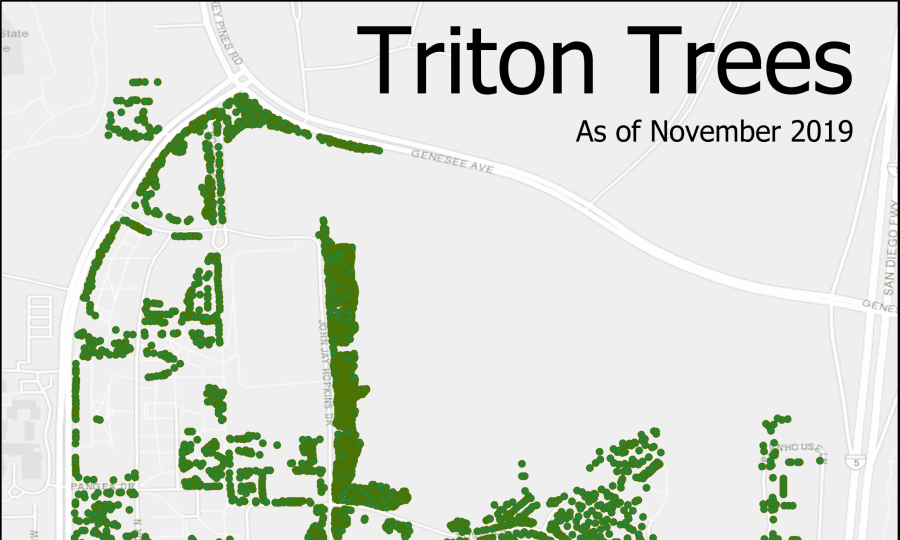Editor’s Note: This article was researched before UC San Diego’s transition to remote learning due to COVID-19. The programs discussed in this article are temporarily not available for student participation.
If you asked UC San Diego students to name a type of tree on campus, most would respond with eucalyptus. After all, the campus was constructed where a vast eucalyptus grove resided, and the Stuart Collection’s installments of “Trees” and “Two Running Violet V Forms” hinge on the leveling of this grove for meaning.
However, despite the eucalyptus trees’ prevalence and recognition, they are far from being the only trees on campus. In fact, there are more than a hundred different species of trees currently growing across UCSD. The beginning of the 2019-2020 academic school year kick-started three new initiatives to encourage greater awareness and support regarding tree diversity on campus.
In honor of Earth Day, The UCSD Guardian compiled this series to share with readers what these new campus initiatives entail and their ultimate goals. Part 1 of the series can be found here and Part 2 here.
Campus Tree Survey
Triton Tree Trust project is a program designed to provide an updated, digital map of every single tree at UCSD through a campus tree survey. This survey’s ultimate goal is to allow the university to be able to measure the overall wellbeing of each campus tree species, observing how their health and oxygen and carbon dioxide levels fluctuate over time. The TTT will also monitor other traits such as the removal of trees, soil health, and erosion.
The mapping process began officially between September and October 2019, inspired and prompted by Urban Forester Mike Hogan and Groundskeeper Chris Johnson. Triton Tree Trust works in close collaboration with Geisel Library’s Data and GIS (Geographic Information System) lab in order to ensure that the surveying process runs smoothly and efficiently for surveyors. The program also works in collaboration with other University of Californias’ geospatial mapping efforts, including UC Davis’ tree map.
According to Amy Work, a GIS librarian at Geisel Library, the project hopes to include students as future surveyors. The program uses a GIS system called “Arbor Pro,” which creates a virtual map of campus with each tree as a different data point. In addition, the GIS lab is currently working to expand the survey’s data collection through an app called “Survey 123,” which would allow students and faculty to contribute to data collection by relying on their phones’ GPS systems, which is ultimately more accurate than Arbor Pro’s system.
“This all gets into crowdsourcing,” Work said. “We live in a day and age where information can be crowdsourced by the general public to contribute to a greater good. And so if we can have that on campus, once we have all the trees mapped… This is really about if we understand the trees on our campus as well, how does that better help us with understanding the climate changes happening around us?”
Participants with the survey go through training to recognize different species of trees by going out with campus groundskeepers and members with facilities management. However, the app’s setup does allow students to participate regardless of their experience or knowledge level. Individuals recording trees into the app’s database are able to upload photos of trees, notes about weather conditions, the methods used to detect the tree, as well as how confident they are about their ability to identify the tree’s species. Submissions to the survey can then be reviewed by trained faculty members to ensure accuracy.
“This is really getting the crowdsourcing of information, we have experts out there, we have novices out there, and it’s a balance of managing that data input,” Work explained. “So can you have a novice map a tree? Well if they submit a photo, then Chris can identify that [tree species] from a photo.”
Keith Pezzoli, an associate teaching professor in the department of urban studies and planning, has also played a key role with the project’s development and guiding several urban studies senior sequence students to participate with the survey.
“UC San Diego is undergoing a culture shift embracing the many benefits of creat[ing] more experiential learning opportunities for students to link knowledge to action,” Pezzoli wrote in a statement to The UCSD Guardian. “TTT is a good way to elevate, understand and improve the use of green infrastructure on campus as a mini city that needs to address climate change.”
“Hopefully, and this is what we’d like to do, that data could be available for students’ projects,” Work said. “So could we allow a student to be able to analyze this data and figure out what tree species is the most popular, or are there factors that could affect the health of that?”
As of mid-February, 16,900 campus trees were counted with the survey. However, even with this great number, large portions of the campus map were yet to be explored, including the UCSD Health hospital and campus housing and dining properties.
Due to the current campus access restrictions, students are not able to contribute to the campus tree survey at this time. However, the program is ongoing, and trees are still being counted this quarter by on-campus groundskeepers, including Johnson. Students interested in helping with the tree surveying process when campus activities resume can learn more by contacting Keith Pezzoli or reaching out to the student organization Roger’s Urban Farmlab.
Image courtesy of Amy Work.













